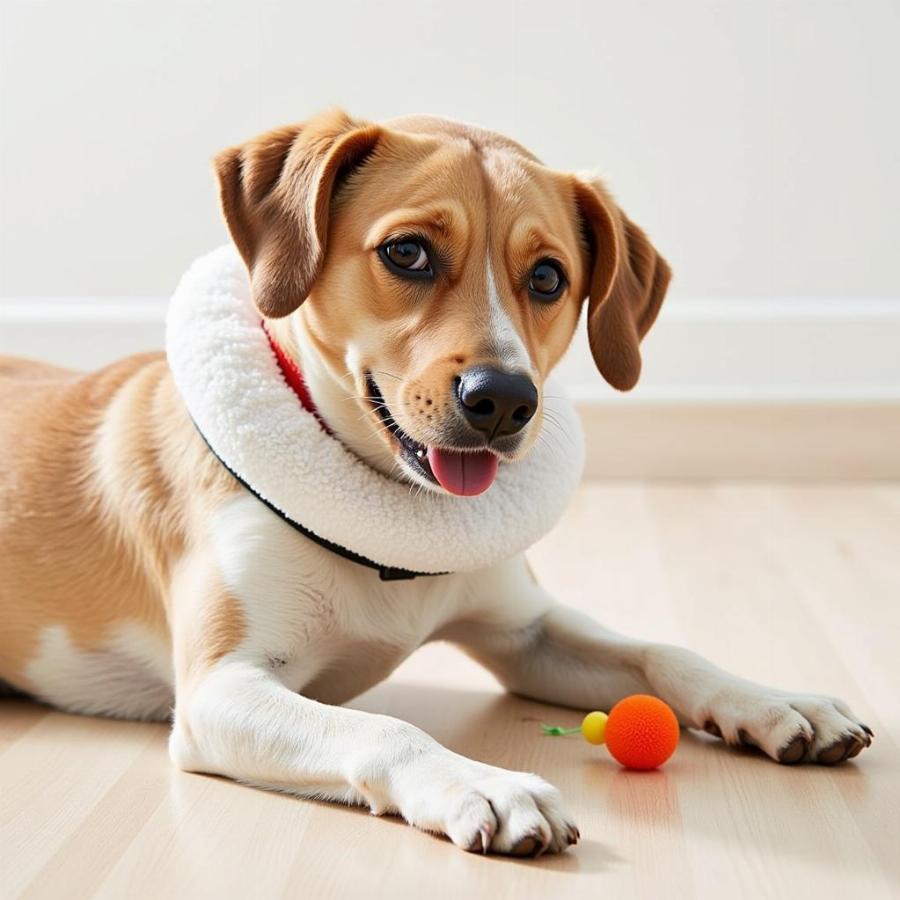Recovering from surgery can be a challenging time for your furry friend. A soft collar for dogs after surgery is a gentler alternative to the traditional “cone of shame” and can provide comfort while preventing your dog from licking or biting their incision site. This guide will delve into everything you need to know about soft collars, from choosing the right one to ensuring a smooth recovery for your beloved pet.
Understanding the Need for a Soft Collar
After surgery, your dog’s natural instinct is to lick or chew at the wound, which can introduce bacteria and disrupt the healing process. A soft collar acts as a barrier, preventing this behavior and allowing the incision to heal properly. Unlike the hard plastic cone, a soft collar offers more comfort and flexibility, allowing your dog to eat, drink, and sleep more easily.
Why Choose a Soft Collar?
- Increased Comfort: Soft collars are made from pliable materials like fabric or foam, providing a more comfortable experience compared to rigid plastic cones.
- Improved Mobility: The flexibility of a soft collar allows for better movement and less restriction, making it easier for your dog to navigate their surroundings.
- Reduced Anxiety: The less intrusive nature of a soft collar can help reduce post-operative stress and anxiety.
- Better Sleep: Soft collars often allow dogs to rest more comfortably, which is crucial for recovery.
Choosing the Right Soft Collar
Choosing the right soft collar is vital for your dog’s comfort and recovery. Consider these factors:
- Size and Fit: Measure your dog’s neck circumference accurately to ensure a snug but not restrictive fit. pig snout for dogs are also good options, offering a different level of protection.
- Material: Look for breathable and washable materials like cotton or padded nylon.
- Closure Type: Velcro, zipper, or buckle closures offer varying levels of security and adjustability.
- Flexibility and Support: The collar should be flexible enough for comfort but provide enough support to effectively prevent access to the wound.
How to Measure Your Dog for a Soft Collar
Use a flexible tape measure and measure around your dog’s neck where a regular collar would sit. Add a couple of inches to this measurement for a comfortable fit. Remember, the collar shouldn’t be so loose that your dog can reach the incision.
Using and Caring for a Soft Collar
Once you’ve chosen the right soft collar, it’s essential to use and care for it properly.
- Introduction: Introduce the collar gradually to your dog, using positive reinforcement and treats.
- Supervision: Supervise your dog while wearing the collar, especially in the initial stages.
- Cleaning: Regularly wash the collar according to the manufacturer’s instructions. cone alternatives for dogs often offer various cleaning options.
- Monitoring: Check the collar regularly for any signs of wear and tear and replace it if necessary.
What if My Dog Keeps Trying to Remove the Collar?
Some dogs may initially try to remove the collar. Distraction with toys, treats, and positive reinforcement can help. If your dog continues to struggle, consult your veterinarian for advice. They might recommend inflatable e collar for dogs or other options.
 Dog Comfortably Wearing a Soft Collar
Dog Comfortably Wearing a Soft Collar
Recovery with a Soft Collar
A soft collar plays a crucial role in your dog’s post-surgical recovery. It provides a protective barrier while allowing for a more comfortable and less stressful healing process.
- Wound Healing: By preventing licking and biting, the soft collar promotes faster and cleaner wound healing. A dog recovery collar can significantly aid in this process.
- Pain Management: Preventing interference with the wound reduces pain and discomfort.
- Infection Prevention: The collar helps keep the incision site clean and free from bacteria, minimizing the risk of infection. Be aware of potential complications like seroma in dogs after surgery.
Conclusion
A soft collar for dogs after surgery is an excellent alternative to traditional cones, providing comfort and promoting healing. By understanding the importance of proper selection, usage, and care, you can ensure a smoother and less stressful recovery for your furry companion.
FAQs
- How long should my dog wear a soft collar after surgery? This depends on the type of surgery and your veterinarian’s recommendations. Typically, it’s for a few weeks.
- Can my dog eat and drink with a soft collar? Yes, soft collars are designed to allow dogs to eat and drink comfortably.
- What if my dog’s soft collar gets dirty? Most soft collars are washable. Follow the manufacturer’s instructions.
- Are there different types of soft collars? Yes, they come in various shapes, sizes, and materials.
- Can I use a soft collar for other injuries? Consult your veterinarian before using a soft collar for non-surgical injuries.
- How can I make my dog more comfortable wearing a soft collar? Use positive reinforcement, provide distractions, and ensure the collar fits correctly.
- Are soft collars safer than traditional cones? Both have their pros and cons. Soft collars are generally more comfortable, but cones may provide more comprehensive protection in certain cases.
Beaut Dogs is your trusted source for all things canine. We provide expert advice and resources to help you provide the best care for your beloved pet. For further assistance, please contact us at Email: [email protected] for detailed and accurate information. Beaut Dogs is committed to supporting you and your furry friend every step of the way.